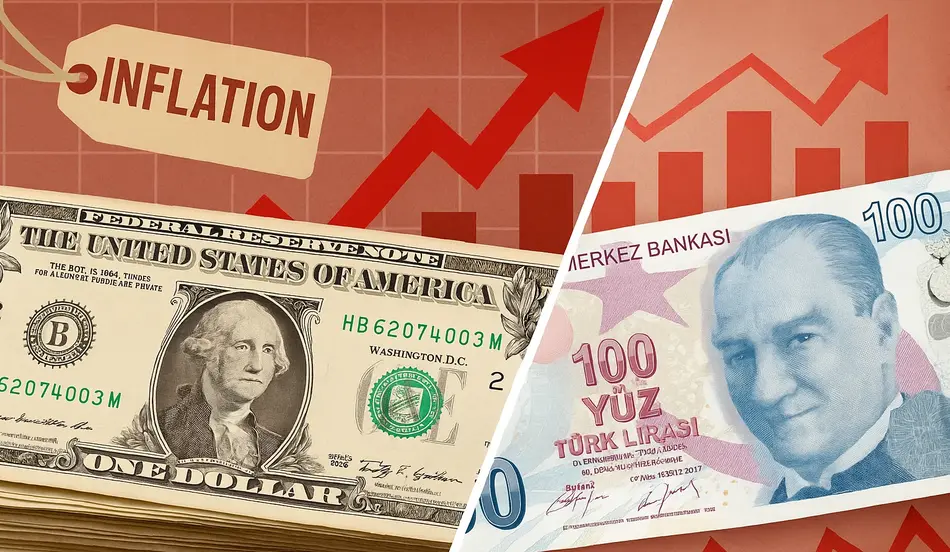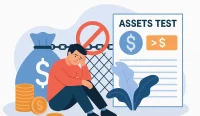Is the US headed for a Turkey-style inflation crisis? This alarming question has gained serious traction as President Donald Trump’s unprecedented assault on Federal Reserve independence reaches dangerous new heights. Last month, Trump attempted to fire Lisa Cook, one of the seven members of the Fed’s Board of Governors, in what appears to be a calculated move to gain control over monetary policy and force through massive interest rate cuts.
The implications are staggering. If Trump succeeds in removing Cook and replacing her with a loyalist, he would effectively have a 4-3 majority on the board. This could allow him to replace all 12 regional Federal Reserve Bank presidents with political allies, giving him de facto control over the Federal Open Market Committee and the ability to set interest rates at will.
Trump has already suggested he wants to cut the Fed’s benchmark interest rate from the current 4.5% down to just 1% – a move that could trigger the kind of inflationary crisis that devastated Turkey’s economy. The parallels to Turkey’s economic collapse under President Recep Tayyip Erdogan are both striking and terrifying.
The Central Bank Independence Crisis: A Foundation Under Attack
Central bank independence is the cornerstone of modern monetary policy, allowing central banks to set interest rates without political interference. This independence is crucial because politicians naturally favor lower interest rates that stimulate short-term economic growth, even when such policies risk dangerous inflation in the medium to long term.
The Federal Reserve’s independence has been carefully designed to span multiple presidencies. The seven board members serve 14-year terms and can only be fired “for cause” – meaning they must actually commit wrongdoing, not simply disagree with presidential policy preferences. This structure was specifically created to insulate monetary policy from political pressure.
However, Trump’s recent actions represent a direct assault on this fundamental principle. His attempt to fire Lisa Cook based on unsubstantiated allegations about property records appears to be a thinly veiled attempt to politicize the Fed and gain control over interest rate decisions.
The stakes couldn’t be higher. When politicians control monetary policy, history shows they consistently push inflation to dangerous and destabilizing levels. The Federal Reserve Act of 1913 was specifically written to prevent exactly this scenario.
The Turkey Parallel: A Cautionary Tale of Economic Destruction
Turkey’s economic crisis under President Erdogan provides a chilling preview of what could happen in the United States. Erdogan seized control of Turkey’s central bank and forced them to cut interest rates despite rising inflation, believing that lower rates would somehow combat inflation – a fundamentally flawed economic theory.
The results were catastrophic:
• Inflation averaged 50% annually between 2022 and 2025
• The Turkish lira lost 70% of its value against the dollar
• Economic growth collapsed as foreign investment fled
• Unemployment soared as businesses struggled with hyperinflation
• Social unrest increased as living standards plummeted
The Turkish crisis demonstrates how quickly political control of monetary policy can destroy an economy. Erdogan’s insistence on keeping rates artificially low while inflation was already running high created a perfect storm of economic destruction that took years to recover from.
The parallels to Trump’s proposed policies are impossible to ignore. Both leaders believe they know better than economic experts, both prioritize short-term political gains over long-term stability, and both are willing to destroy institutional independence to achieve their goals.
The Mechanics of Economic Destruction: How Rate Cuts Could Backfire
Trump’s proposed 3.5 percentage point rate cut from 4.5% to 1% would be economically catastrophic in the current environment. Inflation is already running 0.7 percentage points above the Fed’s 2% target, with core inflation even higher. Additional rate cuts would only fuel further price increases.
The economic mechanics are straightforward but devastating. Lower interest rates would:
• Stimulate excessive borrowing and spending
• Reduce the value of the dollar as investors seek higher returns elsewhere
• Increase import costs as the dollar weakens
• Create asset bubbles in real estate and stocks
• Encourage speculative behavior rather than productive investment
Markets are already pricing in a modest 0.25 percentage point cut at the next Fed meeting, but Trump’s proposed cuts would be 14 times larger than what markets expect. Such aggressive easing would likely trigger a massive sell-off in the dollar and a flight of foreign capital.
The timing couldn’t be worse. Trump’s proposed tariffs would push prices even higher, creating a perfect storm of inflationary pressures that would be exacerbated by artificially low interest rates.
The Legal Battle: Can Trump Actually Fire Fed Governors?
The legal framework surrounding Trump’s attempt to fire Lisa Cook is complex and largely untested. The Federal Reserve Act requires “cause” for removal, but the definition of “cause” has never been clearly established by the courts.
Cook’s alleged misconduct – designating two properties as primary residences – appears to be a minor administrative error rather than the kind of serious wrongdoing that would typically justify removal. Most legal experts believe the “for cause” clause applies to professional misconduct, not personal administrative errors.
However, the courts have struggled to meaningfully resist Trump’s executive actions throughout his presidency. Even if Cook survives this particular challenge, Trump’s campaign against Fed independence is unlikely to end here.
The broader concern is that Trump could use his 4-3 board majority to replace all 12 regional bank presidents with loyalists, effectively giving him complete control over monetary policy without needing to fire any more governors.
The Market Reaction: Early Warning Signs of Crisis
Financial markets have already begun reacting to Trump’s assault on Fed independence. The dollar has fallen markedly since Trump attempted to fire Cook, reflecting investor concerns about the potential for political interference in monetary policy.
Foreign investors are particularly sensitive to central bank independence, as it represents a key indicator of economic stability and institutional strength. Any perception that the Fed is becoming politicized could trigger a massive flight of foreign capital.
The bond market would likely react violently to Trump’s proposed rate cuts, with yields on long-term Treasury bonds spiking as investors demand higher returns to compensate for increased inflation risk. This would increase borrowing costs across the economy, potentially triggering a recession.
Stock markets could initially rally on the prospect of lower rates, but this would likely be short-lived as investors realize the inflationary implications. The eventual correction could be severe, wiping out years of gains for ordinary investors.
The Regional Bank President Strategy: A Backdoor to Control
Trump’s most dangerous strategy involves the 12 regional Federal Reserve Bank presidents, who serve on the Federal Open Market Committee on a rotating basis. All 12 presidents are due for reappointment in February 2026, and their reappointment can technically be vetoed by a simple majority of the board.
This means Trump could use his 4-3 board majority to replace all 12 regional bank presidents with political loyalists, giving him effective control over the FOMC without needing to fire any more governors. This would be unprecedented in Fed history but technically legal.
The regional bank presidents are crucial because they represent the Fed’s connection to local economies and provide diverse perspectives on monetary policy. Replacing them all with political appointees would destroy this institutional diversity and create a rubber-stamp committee.
This strategy would be particularly dangerous because it would allow Trump to implement his radical rate-cutting agenda while maintaining the appearance of Fed independence. The public might not realize the extent of political control until it’s too late.
The Inflationary Perfect Storm: Multiple Threats Converging
The current economic environment creates a perfect storm of inflationary pressures that would be exacerbated by Trump’s proposed policies. Multiple factors are already pushing prices higher, and additional rate cuts would only make the situation worse.
Trump’s proposed tariffs would directly increase the cost of imported goods, pushing consumer prices higher. Combined with artificially low interest rates, this would create a dangerous feedback loop where inflation expectations become unanchored.
The labor market remains tight, with unemployment near historic lows and wage growth accelerating. Lower interest rates would further stimulate demand for labor, pushing wages even higher and creating additional inflationary pressure.
Supply chain disruptions and geopolitical tensions continue to create bottlenecks in global trade, while climate change is increasing the frequency of supply shocks. These structural factors would be amplified by expansionary monetary policy.
The combination of these factors could easily push inflation well above the Fed’s 2% target, potentially reaching levels that would require much higher interest rates to control – exactly the opposite of what Trump wants to achieve.
Frequently Asked Questions
Is the US headed for a Turkey-style inflation crisis?
Is the US headed for a Turkey-style inflation crisis? The risk is real if Trump gains control of the Fed and cuts rates to 1% while inflation is already above target, potentially triggering the same economic destruction that devastated Turkey under Erdogan.
How could Trump gain control of the Federal Reserve?
Trump could gain control by replacing Fed governors with loyalists to achieve a 4-3 board majority, then using that majority to replace all 12 regional bank presidents, effectively controlling the Federal Open Market Committee.
What happened to Turkey’s economy under Erdogan’s control?
Turkey’s economy collapsed under Erdogan’s control with inflation averaging 50% annually, the lira losing 70% of its value against the dollar, economic growth collapsing, and social unrest increasing as living standards plummeted.
Why would Trump’s proposed 1% interest rate be dangerous?
Trump’s proposed 1% interest rate would be dangerous because inflation is already above the Fed’s 2% target, and such aggressive rate cuts would fuel further price increases, weaken the dollar, and create asset bubbles.
What are the legal obstacles to Trump firing Fed governors?
Legal obstacles include the Federal Reserve Act requiring “for cause” removal, with most experts believing this applies to professional misconduct rather than minor administrative errors like Cook’s property designation issue.
How would markets react to political control of the Fed?
Markets would likely react with a falling dollar, flight of foreign capital, spiking bond yields, and eventual stock market correction as investors realize the inflationary implications of political interference.
What is the regional bank president strategy?
The regional bank president strategy involves using a 4-3 board majority to replace all 12 regional bank presidents with loyalists, giving Trump effective control over the FOMC without needing to fire more governors.
A Real-World Example: The Small Business Owner’s Nightmare
Maria Rodriguez, owner of a small manufacturing business in Ohio, is already feeling the pinch of inflation and fears what Trump’s proposed policies could mean for her company. “We’re already struggling with higher costs for materials and supplies,” she explains. “If Trump gets his way and cuts rates to 1%, I’m terrified about what that will do to prices.”
Maria’s business depends on imported components from China, and Trump’s proposed tariffs would directly increase her costs. “We’re looking at 25% tariffs on our main inputs,” she says. “Combined with lower interest rates that would push up demand, I don’t know how we’ll stay competitive.”
The potential for a Turkey-style crisis keeps Maria awake at night. “I’ve been reading about what happened in Turkey, and it’s scary how similar the situation is,” she explains. “Erdogan thought he knew better than the economists, just like Trump does. Look where that got Turkey.”
Maria’s concerns extend beyond just her business. “If inflation gets out of control like it did in Turkey, it won’t just hurt businesses – it will destroy families,” she says. “People won’t be able to afford basic necessities. That’s not the America I want to live in.”
The uncertainty is already affecting Maria’s business decisions. “I’m holding off on major investments because I don’t know what the economic environment will look like in six months,” she says. “That’s not good for growth, but I can’t risk making big commitments when the rules could change overnight.”
Maria’s story illustrates how Trump’s assault on Fed independence isn’t just a political issue – it’s a real threat to ordinary Americans who depend on economic stability for their livelihoods and futures.
Don’t Let Political Interference Destroy Economic Stability
The question “Is the US headed for a Turkey-style inflation crisis?” is not hyperbole – it’s a legitimate concern based on clear historical precedent and current political developments. Trump’s assault on Fed independence represents an existential threat to economic stability that could devastate millions of American families.
The Federal Reserve’s independence has been carefully designed to protect the economy from exactly this kind of political interference. Allowing Trump to destroy this independence would be a catastrophic mistake that could take decades to recover from.
The stakes are too high to remain silent. Americans must understand the real risks of political control over monetary policy and demand that their elected representatives protect the institutional independence that has served the economy well for over a century.
The time to act is now, before it’s too late. Don’t let political ambition destroy the economic foundation that has made America prosperous.




